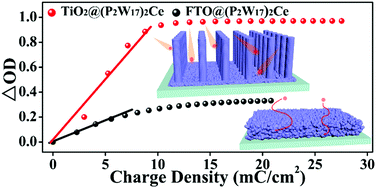Construction of a vertically arrayed three-dimensional composite structure as a high coloration efficiency electrochromic film†
Abstract
Polyoxometalate-based electrochromic materials have been investigated for a long time due to their excellent redox reversibility while giving rise to colored mixed-valence state species. However, similar to traditional inorganic electrochromic materials, the response time and coloration efficiency of polyoxometalate-based materials still need to be improved. Herein, a nanocomposite thin film composed of a composite mono-cerium substituted sandwich-type polyoxotungstate cluster K17[Ce(P2W17O61)2]·nH2O and TiO2 nanowires is constructed via an electrodeposition method. Scanning electron microscopy (SEM), transmission electron microscopy (TEM), atomic force microscopy (AFM) and X-ray photoelectron spectroscopy (XPS) are used to investigate the surface morphology, structure, components and chemical properties of the nanocomposite film. The electrochemical experiments are performed by combining an in situ UV-vis spectrophotometer with an electrochemical workstation. Compared with the pure K17[Ce(P2W17O61)2]·nH2O modified film, the composite film exhibits a high transmittance modulation (73.2% at −1 V), fast response time (2.6 s for coloration and 1.7 s for bleaching), better cycle stability and particularly improved coloration efficiency (111.3 cm2 C−1). Combining the characterization and electrochemical test results, the obviously enhanced electrochromic properties could be attributed to the unique 3D structure of the TiO2 nanowire substrate, which could provide high specific surface area and fast reacting kinetics characteristics.



 Please wait while we load your content...
Please wait while we load your content...